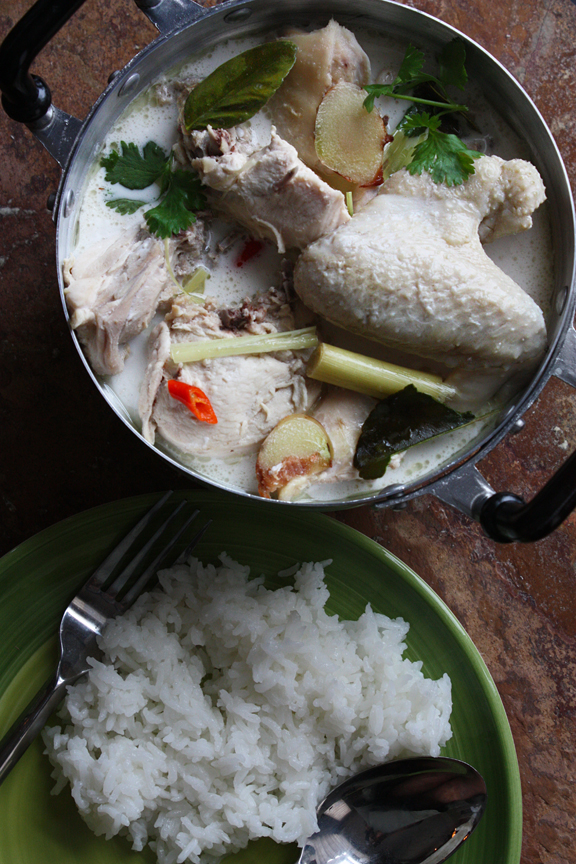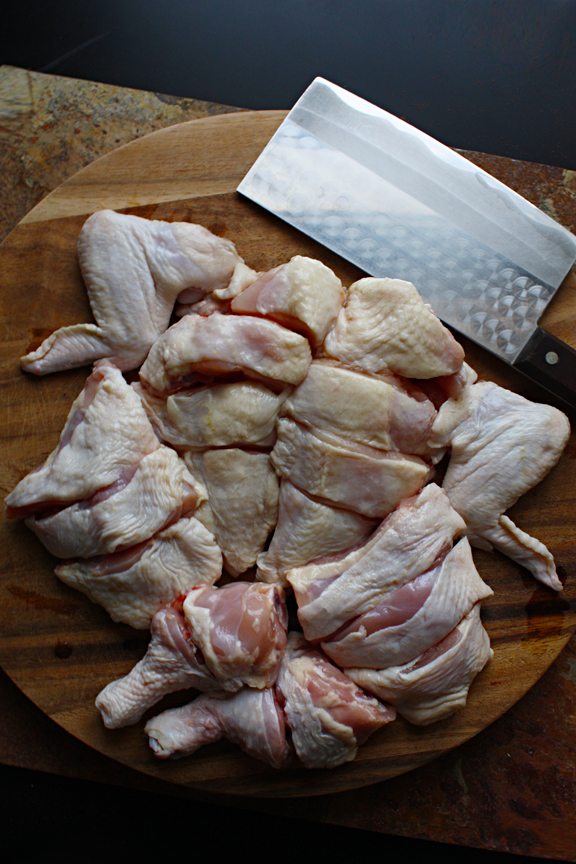
Yesterday afternoon, as I was hacking up a chicken with a cleaver to make this pot of Tom Kha Gai, my mind wandered off to one of my older posts on Serious Eats on chicken massaman curry and the comments it had elicited (which I find very educational). That had led to this impromptu post.
One of the biggest culture shocks I experienced during the first few months in the United States had nothing to do with differences in terms of language (though that was — still is — a challenge), the use of symbols and figures of speech (I’d learned along the way how to handle that), or etiquette.
It was the bonelessness and skinlessness of meat dishes I noticed.
After spending the first few weeks in the US wondering what was off about meat dishes at stateside Asian restaurants, I finally figured out that it was the fact that they were almost always boneless and skinless — you know, the dishes that would have come with bones and skin in Asia, the dishes that would have required some gnawing action on my part.
Then I started noticing that at potluck parties, people didn’t respond so well to my Asian meat dishes when they were prepared and presented in the way that was appetizing to me. I learned from it. When it comes to cultural differences, there’s no right or wrong — no better or worse. You don’t judge; you acknowledge.
Thai people in general are quite comfortable with whole fish with eyes looking back at us, head-on shrimp, bone-in and skin-on pieces of chicken, whole fish cut cross-wise into steaks, etc. We’re used to filleting a fried mackerel with a spoon and a fork at the table. The crispy tail ends of grilled chickens? There’s always someone in your family who would fight with you over those. Then there’s that cousin who is fond of eating the heads of deep-fried fish or sucking the juices and tomalley out of large prawns.
We also like to cook with bone-in meat. We’re comfortable with leaving the bones in. We don’t mind eating around them. We don’t mind eating the soft cartilage and even some of the bones that have been stewed until soft or fried until crunchy. (Read Kenji Lopez-Alt’s view regarding why bones are often left in Asian meat dishes.)
Herbs and spices floating in a curry or soup? We’re fine with those too. When I see a piece of dried spice in my massaman curry, I can’t resist picking it up and sucking on it, because, man, the sauce that adheres to it is so fragrant. I love it so much I sometimes forget that people from a different culture may feel differently. And even though intellectually I’m aware of this type of cultural disparity, once in a while I’m reminded by questions and comments from my readers of how I can’t assume that the way I see/do/like things must be the way others see/do/like things.
It’s all good. Part of education.
But for what it’s worth, what you see here is how I make Tom Kha Gai* at home.
When I help my readers recreate the dish as it’s made at their favorite Thai restaurants, I take away the skin and the bones. In my own kitchen, I cut up a whole chicken with a cleaver and bring out the flavor of the bones into the broth through long, slow cooking. There’s nothing wrong with slicing friendly boneless, skinless chicken breasts into bite-sized pieces and compensating for the lack of umami with chicken broth — there’s always more than one way to do anything; it’s just not the kind of Tom Kha Gai I grew up eating or prefer.
If you’re interested in making Tom Kha Gai this way, you can give it a try. Simply cut up a whole chicken into large chunks, put the pieces in a large pot, add just enough water to cover them plus some fish sauce to flavor the chicken while it’s cooked, and let the pot simmer for 40-50 minutes, replenishing the water along the way as necessary. Then add the bruised herbs to the pot (and mushrooms, if you’re in a fungus mood), let the whole thing continue to cook and infuse for 10 minutes, add coconut cream to it, heat it gently, and take the pot off the heat. More fish sauce, if necessary, goes in at this time along with fresh lime juice, crushed fresh chilies, and cilantro leaves. (For this to make sense, consult the post on how to make Tom Kha Gai.)
The broth is full of flavor — the kind of flavor boneless, skinless chicken breast meat will never be able to give you.
Oh, and the herbs floating about in the soup? You can remove them, if they bother you. Or you can do what most Thai people do: leave them in there and eat around them.
* RTGS: tom kha kai








41 Responses to Tom Kha Gai, the Rustic Way